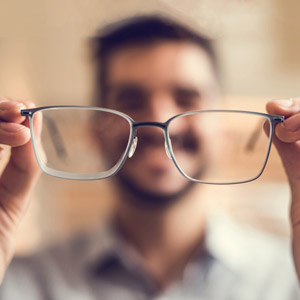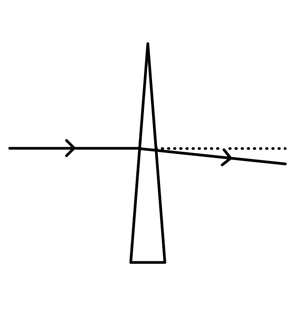Eye alignment is critical to optimal functioning. Slight discrepancies place immense strain on the eye muscles. Occasionally seeing double is a clue that there might be an alignment problem – this is often more apparent when the individual is tired.
Prismatic correction has been built into your spectacle correction to assist your eyes to properly align when looking at an object. This is most often the difference between being able to see, or being able to see comfortably, without the visual strain associated with conditions requiring prismatic correction. These conditions are usually subtle, but can be the difference between visual fatigue and visual comfort. This is particularly significant if the misalignment is in the vertical plane. Prismatic misalignment results in diplopia (double vision) and is typically more apparent when the individual is tired. It is also commonly responsible for persistent headaches. A child that constantly closes one eye can be a clue that a misalignment might be the cause.
Individuals with a small misalignment will commonly have difficulty looking through binoculars as they are not able to fuse the images for each eye.
Requirements
In Spectacles, prisms are used primarily to correct:
- Double vision
- Positional correction
- Convergence correction
Double vision or Diplopia occurs when a viewer sees two individual images while using both eyes, rather than one combined 3D image. A prismatic lens is used to move the images so that they overlap and allow for the foundation of binocular vision. Prisms can shift an image in any direction depending on how it has been positioned in front of the eye. Your eye examination revealed the need to introduce some degree of prismatic correction to relieve the strain on your visual system.
In some cases individuals do not experience double vision, but they have a “tendency to double vision. Very often double vision can be overcome by their eye muscles shifting their position so that the the images overlap. This can happen for short periods of time but puts immense unnatural strain on the visual system. Once the visual system breaks down when the individual is tired or after long periods of constant concentration, diplopia results. In most cases this can be completely corrected with prisms affording the spectacle wearer with comfortable binocular vision or minimal diplopia. These misalignments are very significant even when as little as a quarter of a millimeter.
. Positional correction is when each eye sees the same image but in different positions. This can be either up, down, left, right or even a combination of two. Prisms are used in this instance to shift the image to a position where the eye is at rest, thus alleviating the eyestrain.Convergence correction is used in instances where the eyes are not able to adequately converge to see near objects as a single object, particularly noticeable when reading. Clues that this might be occurring is when individuals report they constantly “lose their place” while reading or that the “letters are swimming or moving”. Another typical complaint is that individuals report they can only read one or two pages and then are not able to continue because they become too tired or reading becomes difficult because the words and letters are “running into each other”. Prisms built into reading glasses are able to shift the images seen by each eye so that the overlap requires less effort.
Off the shelf reading glasses often cause unnatural eye fatigue as the lens centers are typically placed in the center of the frame and if this does not exactly coincide with the distance between your eye centers the unwanted prism causes your eyes to squint slightly in order to avoid double vision. This puts undue strain on the very sensitive focusing and eye muscle system which is now out of balance.
In cases of school children, prisms are not usually used for convergence insufficiencies, but rather eye exercises are the treatment of choice, as this mostly can alleviate the problem in young children. Clues that this is an issue is typically children who report they “hate reading” or close one eye while reading or use their finger to track while reading.
Adaptation
There is always an Adaptation period for any new lenses, especially It is normal for you to experience this when you start wearing a new pair of Spectacles where Prism has been built into your lenses. It is normal to experience mild headaches initially, but as your eyes learn to relax, and let the prisms do the alignment work, you will then get the full benefit of your new lenses.
Most people report that when wearing lenses with some degree of prism built in, these issues are relatively mild and disappear as they adapt to wearing the lenses over a period of a few days. Be fair to yourself by giving yourself a few days to adapt to your new lenses.
Materials
These lenses are available in plastic and glass material. Technological and chemical advancements have produced Plastic materials that are well suited to spectacle lenses.
The plastic material most commonly used is known as CR39("Columbia Resin 39"). It is a thermal-cured plastic developed in the early 1940s. CR-39 plastic remains a popular material for spectacle lenses because of its light weight (about half the weight of glass), low cost and excellent optical qualities.Polycarbonate Material developed in the early 1970s, is also used due to its incredible impact resistance. Polycarbonate lenses became increasing popular and remain so today. This material is used for helmet visors for the Air Force, for "bulletproof glass" for banks and other safety applications, polycarbonate is lighter and significantly more impact-resistant than CR-39 plastic, making it a good material for children's eyewear, safety glasses and sports eyewear.
A newer lightweight lens material with similar impact-resistant properties as polycarbonate called Trivex was introduced for eyewear in 2001. The advantage of this material is its superior optical properties compared to polycarbonate.
Refractive Index
The refractive index of lenses refers to the light bending properties of the specific material. The more “dense” the material, the higher the refractive index. For example, Air has a refractive index of 1. And pure water has a refractive index of 1.33, and the densest clear material known to man is a diamond, which has a refractive index of 2.4. the higher refractive index also means the specific material reflects light more, as the light cannot enter it easily due to the increased density of the material, that is why diamonds “sparkle” as they do because they reflect the light more.
The refractive index of plastic ranges from 1.498 (CR-39 plastic) to 1.74 (a specific variety of high-index plastic). So, for the same prescription power and lens design, a lens made of CR-39 plastic will be the thickest and a lens made in 1.74 index plastic will be the thinnest.
The higher index lenses on the downside tend to reflect light more, and for this reason it is essential to treat the surfaces of these lenses with an Anti-reflective coating.

